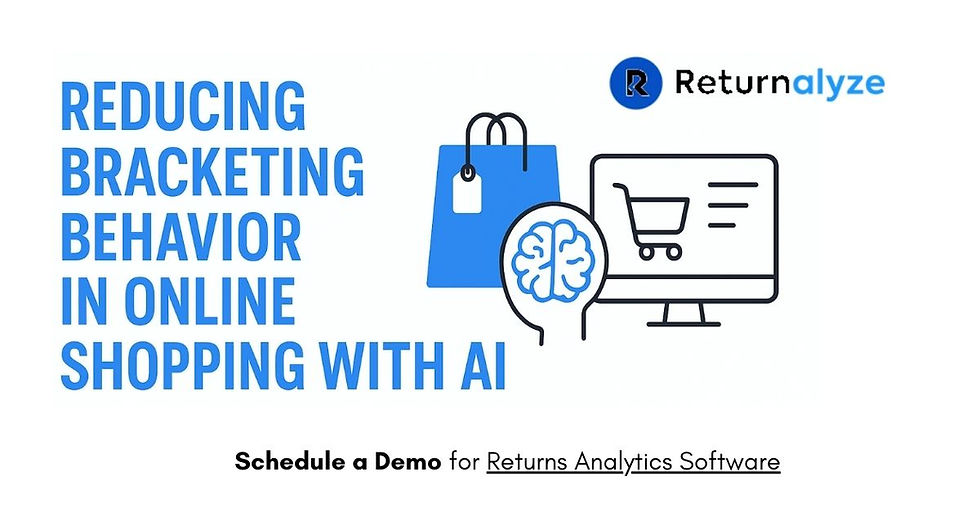AI Return Prevention Strategies to Boost Peak Season & Holiday Sales
- returnalyze
- Aug 21
- 4 min read

As the peak season and holiday sales approach, eCommerce brands face both unprecedented opportunities and operational challenges. Among the most pressing issues is managing product returns effectively, which directly impacts profit margins, customer satisfaction, and brand reputation.
By leveraging AI returns prevention strategies, retailers can significantly reduce return rates, optimize inventory, and enhance the overall shopping experience during the busiest time of the year.
The Rising Challenge of Returns During Peak Season
During high-volume sales periods such as Black Friday, Cyber Monday, and holiday shopping weeks, return rates often surge. Research shows that online return rates can reach 20-30%, with apparel and footwear facing even higher percentages. This spike is driven by multiple factors:
Gift purchases where recipients request exchanges.
Impulse buying encouraged by discounts.
Size and fit issues in fashion and apparel.
Misleading product expectations due to incomplete or inaccurate descriptions.
Without effective returns prevention strategies, these issues can overwhelm fulfillment centers, inflate costs, and strain customer service operations.
How AI is Transforming Retail Returns Prevention?
Artificial Intelligence (AI) is not just automating tasks; it’s predicting, preventing, and proactively managing returns before they occur. AI models process historical return data, customer behavior patterns, and real-time sales insights to identify risks early and intervene with tailored solutions.
Key benefits of AI for returns prevention include:
Predictive Return Analytics – Identifying products with high return probability.
Size and Fit Optimization – Providing personalized recommendations based on past purchases and body measurements.
Product Return Prevention Strategies – Detecting misleading product details and improving content accuracy.
Proactive Customer Communication – Addressing buyer concerns before shipment to prevent dissatisfaction.
Data-Driven Insights to Improve Ecommerce Returns Prevention
By analyzing product-level return patterns, AI can pinpoint which SKUs are most prone to returns and why. Retailers can then:
Adjust product images to better reflect reality.
Add detailed sizing charts and fit guides.
Highlight common customer feedback to set accurate expectations.
Temporarily reduce marketing emphasis on problematic SKUs during peak periods.
For example, if a particular winter coat has a 15% return rate due to size complaints, AI can recommend adjusting size labels, updating the fit description, or bundling size guidance with marketing campaigns.
AI-Enhanced Size and Fit Recommendations
One of the top reasons for returns in apparel and footwear is incorrect sizing. AI systems use machine learning algorithms to analyze customer purchase history, brand-specific sizing variations, and even body shape predictions to offer:
Personalized size suggestions at checkout.
Virtual try-on tools powered by augmented reality (AR).
Size comparison features that match a shopper’s previous purchases with current selections.
These solutions are central to ecommerce returns prevention, especially during holiday gift shopping, when the buyer may not know the recipient’s exact size.
Preventing Misrepresentation with AI-Powered Content Optimization
Misleading product information is another major driver of returns. AI tools can scan product descriptions, reviews, and customer photos to identify mismatches between marketing and reality.
AI-driven product return prevention strategies include:
Enhancing descriptions with material details, dimensions, and use cases.
Analyzing negative review trends to adjust product copy.
Identifying and replacing low-quality product images.
Real-Time Fraud Detection in Retail Returns Prevention
Peak seasons often see a rise in return fraud - such as wardrobing (wearing and returning), counterfeit returns, or switching items. AI systems can detect suspicious patterns in return requests, flag high-risk customers, and require additional verification steps. This not only prevents revenue loss but also ensures legitimate customers continue to enjoy smooth returns.
Dynamic Return Policy Optimization with AI
A one-size-fits-all return policy can encourage unnecessary returns. AI enables retailers to create dynamic, product-specific return policies that adapt based on historical return rates, product category, and inventory levels.
Examples include:
Shortening the return window for seasonal items like holiday decorations.
Offering store credit instead of refunds for clearance items.
Encouraging exchanges by offering incentives for alternative purchases.
Proactive Customer Engagement for Ecommerce Returns Prevention
AI chatbots and virtual shopping assistants can provide instant support during the buying process, helping customers choose the right product, confirm details, and resolve doubts before purchase. This pre-purchase engagement is a key tactic in reducing post-purchase dissatisfaction during the holiday rush.
Integrating AI Returns Prevention in Retail Operations
Leading returns analytics platforms like Returnalyze leverage AI to give brands a single view of returns data, identify trends, and offer actionable prevention insights. Integration with eCommerce platforms such as Shopify, Magento, or BigCommerce ensures real-time synchronization of data across sales, fulfillment, and customer service teams.
Best Practices for Implementing AI for Returns Prevention
Start Early – Begin analyzing return data at least 90 days before peak season.
Integrate with Existing Systems – Ensure AI tools connect with CRM, inventory, and eCommerce platforms.
Train Teams on AI Insights – Help customer service, merchandising, and marketing teams act on AI recommendations.
Monitor in Real Time – Use dashboards to track return prevention KPIs daily during peak season.
Continuously Optimize – Post-holiday analysis should feed back into year-round retail returns prevention strategies.
Turning Peak Season Challenges into Opportunities
The peak season and holiday sales period can either be a revenue goldmine or a logistical nightmare. Implementing AI returns prevention not only minimizes avoidable returns but also enhances operational efficiency, boosts customer satisfaction, and safeguards profit margins.
The most successful brands are those that combine AI-driven insights with proactive, customer-focused return prevention strategies - turning potential losses into opportunities for loyalty and growth.
At Returnalyze, we specialize in empowering retailers with AI-driven ecommerce returns prevention tools that cut return rates, lower operational costs, uncover hidden revenue opportunities, and enhance customer loyalty.
Our platform provides a unified, real-time view of all returns data, enabling you to take proactive, data-backed actions before returns even occur. This holiday season, don’t just react to returns - prevent them with precision.
Contact Returnalyze today to discover how our AI for returns prevention can transform your peak season results.



Comments